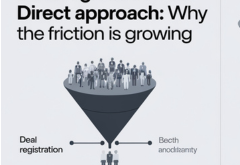In this exclusive interview, Amit Singh explores the dynamic landscape of cybersecurity challenges with Vivek Srivastava, Country Manager, India & SAARC, at Fortinet. The conversation delves into the pressing issues of tool sprawl, extended response times, automation challenges, and the pivotal role of vendor consolidation in fortifying organizational defenses. Gain insights into how Fortinet’s innovative solutions are reshaping cybersecurity strategies, offering rapid responses, and simplifying complex security infrastructures for modern enterprises.
How are organizations overcoming challenges associated with tool sprawl in the cybersecurity landscape?
The modern cybersecurity environment often suffers from tool sprawl, where organizations deploy numerous disparate security solutions. This scenario, while intended to bolster defenses, inadvertently complicates management and reduces overall visibility. Tool sprawl leads to significant challenges, including operational inefficiencies and increased vulnerability. The diversity of interfaces and protocols strains resource management and obscures the visibility necessary for effective threat detection and response.
Fortinet addresses these challenges through its Security Fabric platform, offering a unified security ecosystem. This approach simplifies cybersecurity management, consolidating various tools into a cohesive framework that enhances operational efficiency and security visibility. Adopting Fortinet’s integrated solutions streamlines operations and improves threat response capabilities. Organizations gain enhanced visibility across their digital landscapes, enabling quicker and more accurate threat detection and mitigation efforts.
As per recent studies, security teams take approximately 6 days, with 60% of organizations taking longer than 4 days, to resolve security alerts. How critical is this extended response time, and what are the potential consequences in a threat landscape where attackers act within hours?
The critical nature of this lag in response time cannot be overstated. Cyber attackers are increasingly agile, often breaching and navigating through networks with speed and precision that current organizational response times cannot match. The average “dwell time”—the average period an attacker remains undetected within a network—still hovers around 6 months, providing ample opportunity for significant damage and data exfiltration.
Fortinet’s Security Operations solutions have been pivotal in addressing this critical gap. By implementing Fortinet’s advanced security technologies, organizations have seen dramatic reductions in the time to identify threats. The average time to detect threats, which could extend to 168 hours (or about 21 business days) without effective detection tools, is reduced to less than an hour, and in many cases, just seconds with Fortinet’s Endpoint Detection and Response (EDR) technologies.
Moreover, the time required to triage these threats has been reduced from an average of eight hours to just 10 minutes. Most impressively, containment times have dropped from 4.2 hours to a mere one minute, showcasing Fortinet’s commitment to rapid response and containment capabilities.
What are the challenges faced by organizations while automating their defenses?
The deployment of automation and orchestration in cybersecurity is critically undermined when organizations rely on poorly integrated security tools. Disjointed security solutions create an environment where data is siloed, and automation efforts can’t reach their full potential. Automation relies on the seamless flow of information between tools to trigger responses to detected threats. When these tools are poorly integrated, the lack of cohesive data and operational inconsistencies result in slower threat detection, delayed responses, and ultimately, a higher risk of successful cyber-attacks.
Fortinet tackles these challenges with its comprehensive suite of CARA (Cybersecurity Automation, Response, and Analysis) components. This integrated approach ensures that automation and orchestration are not hampered by the limitations of disparate tools. By harmonizing data across the security landscape, Fortinet enables organizations to employ more sophisticated and efficient automated defenses.
With Fortinet’s solutions, the time to investigate threats has been drastically reduced from 6 hours to 1 minute or less. This acceleration is a testament to the power of integrated automation and orchestration, which can sift through vast amounts of data to identify threats with unparalleled speed and accuracy. Furthermore, the time to remediate identified threats has been cut from 12.5 hours to between 5 and 10 minutes in most cases, showcasing the effectiveness of Fortinet’s automated response capabilities.
In light of the increasing trend toward cybersecurity vendor consolidation, how does Fortinet address the industry’s need for a streamlined and effective defense ecosystem?
The strategic shift towards cybersecurity vendor consolidation is a clear response to the complexities and inefficiencies stemming from a sprawling security tool landscape. Organizations are increasingly recognizing the imperative to streamline their cybersecurity infrastructure to bolster their defense mechanisms against sophisticated cyber threats.
According to a recent Gartner survey, the trend of organizations pursuing a vendor consolidation strategy has surged from 80% in 2022 to an impressive 97% in 2023. This sharp increase underscores a widespread industry realization that a consolidated cybersecurity approach not only simplifies security operations but also enhances the effectiveness of an organization’s overall security posture.
Fortinet has been at the forefront of this consolidation movement with its Security Fabric platform, which has been instrumental in providing over 50 integrated security products. This convergence of networking and security solutions within a single platform empowers organizations with seamless threat intelligence sharing and comprehensive visibility across their entire digital attack surface.
 Latest Technology News Today – Get Latest Information Technology Updates and Services Latest Technology News Today – Get Latest Information Technology Updates and Services
Latest Technology News Today – Get Latest Information Technology Updates and Services Latest Technology News Today – Get Latest Information Technology Updates and Services 









